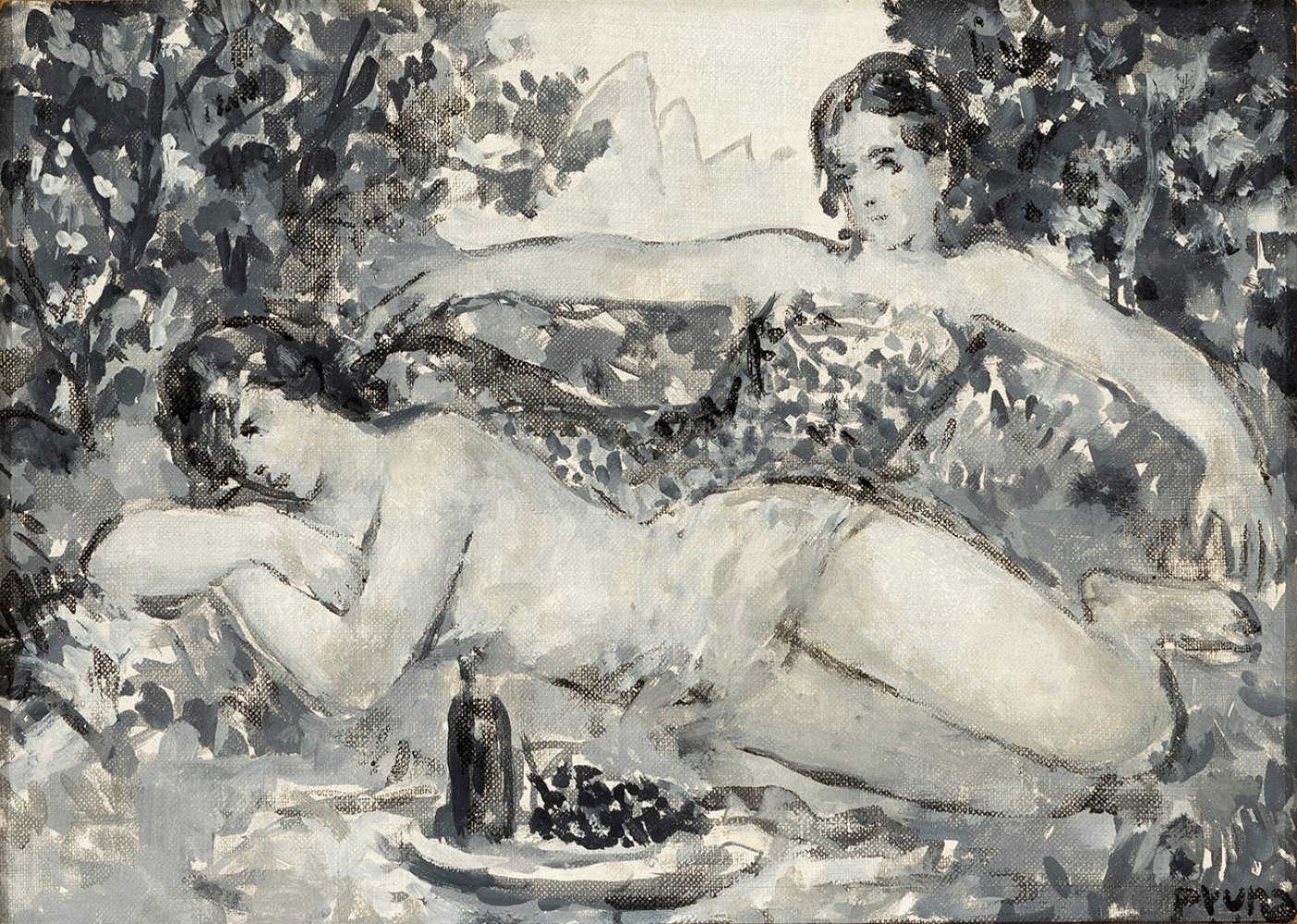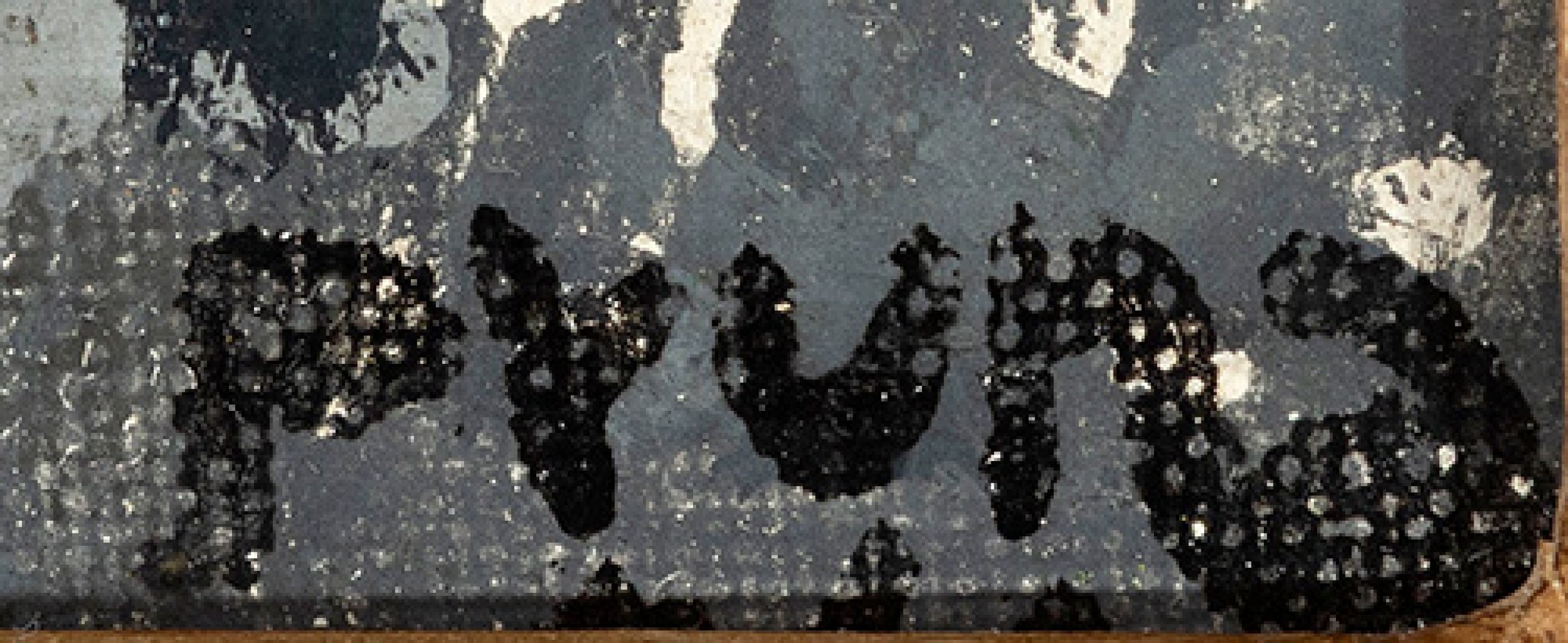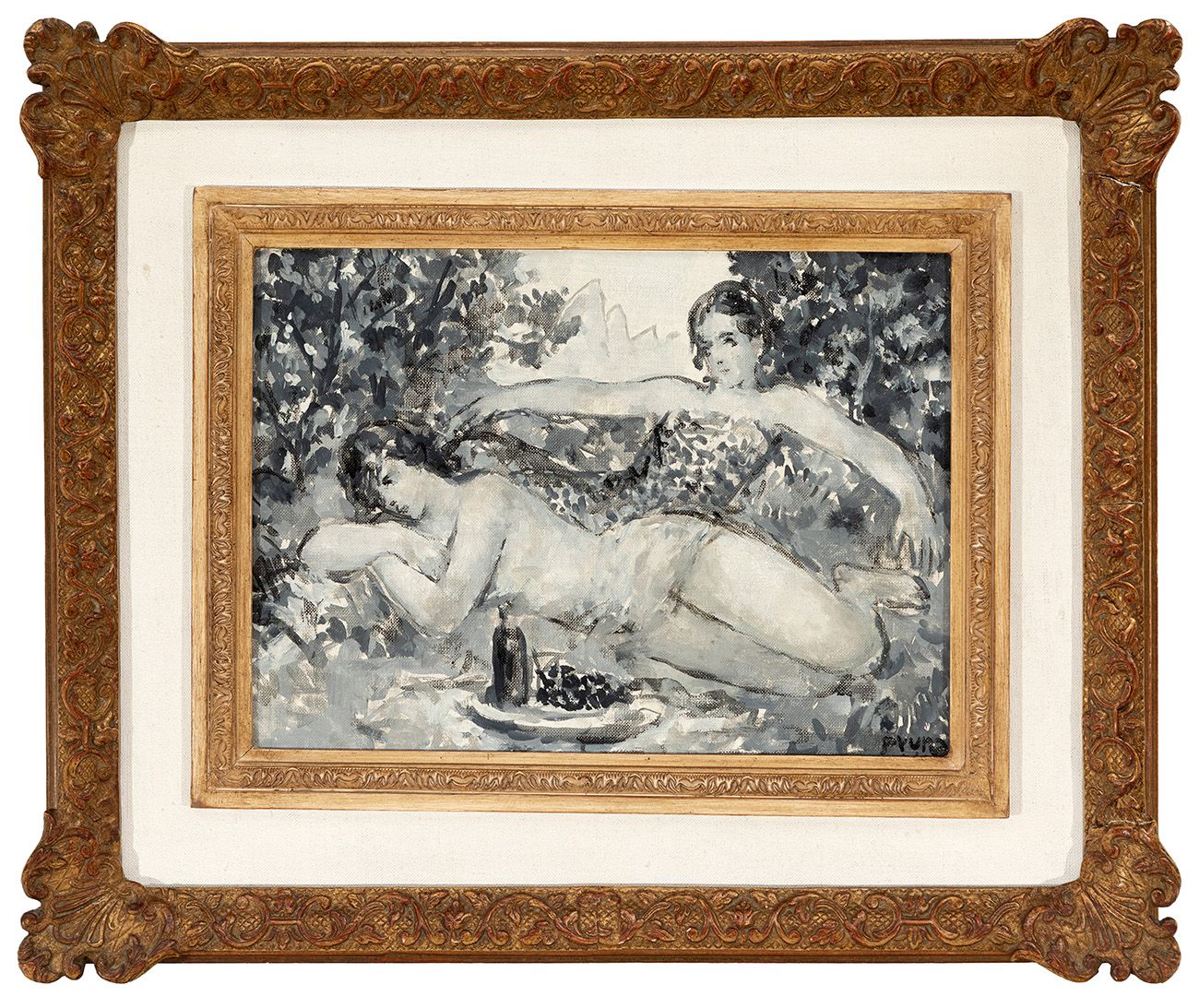33
PERE PRUNA OCERANS (Barcelona, 1904 - 1977)."Two figures in a field".Oil on canvas.Signed in the
"Two figures in a field".
Oil on canvas.
Signed in the lower right corner.
Old Sala Parés label on the back.
Measurements: 27 x 36 cm; 43 x 52 cm (frame).
A mainly self-taught artist, Pere Pruna completed his training at the School of Fine Arts in Barcelona. After beginning to exhibit in Barcelona when he was still very young, he travelled to Paris in 1921, where he was helped and guided by Picasso. In the French capital he held a successful one-man show at the Galerie Percier, and came into contact with intellectuals such as Cocteau, Drieu la Rochelle, Max Jacob and others, with whom he founded the magazine "Philosophie" in 1924. Serge Diaghilev, who visited one of his exhibitions, also asked him to create the sets and costumes for the ballet "Les matelots" in 1925. From then on, he also worked on other musical works, such as "La vie de Polichinele" (1934) and "Oriane" (1938), among others. In 1928 he won second prize in the Carnegie Institute exhibition in Pittsburg and later, on his return to Barcelona, he won other awards such as the "Montserrat seen by Catalan artists" competition (1931) and the Nonell Prize (1936). The latter was surrounded by controversy, because Pruna won it for his oil painting "El vi de Chios", for which he used a photograph published in a Parisian pornographic magazine as a model. In response to the uproar, Pruna withdrew the prize, but the jury upheld its decision. Following the outbreak of the Civil War, Pruna settled in Paris and continued his international exhibition activity, most notably the exhibition organised in London in 1937. At the same time he worked for Ridruejo's propaganda services, with works such as the poster commemorating the promulgation of the Labour Force, and Eugenio d'Ors, National Head of Fine Arts, introduced him to the Spanish representation at the Venice Biennale in 1938. After the war he combined easel painting exhibitions with mural painting, a genre in which his work in the Monastery of Montserrat was particularly celebrated. In 1965 he won the City of Barcelona Prize, and three years later he was appointed academician of the Far de Sant Cristòfor. His style, centred on a graceful, stylised female figure, is based on the clear delicacy of the pink and "neoclassical" Picasso, and reveals a certain parallelism with the Italian Novencento, being fully in keeping with the classicist trend that appeared in Western art after the first wave of avant-gardism and of which his friend Cocteau was the driving force. Pruna focused on portraiture and above all on the female figure, capturing images marked by great delicacy and sober distinction. His representations are characterised by a stylised and diaphanous line, and are in tune with the return to order following the rupture that Cubism represented in France, thus linking directly with the avant-garde. Pere Pruna is currently represented in the Museum of Montserrat, where there is a space bearing his name, the MACBA in Barcelona and the Maricel Museum in Sitges, among others.
"Two figures in a field".
Oil on canvas.
Signed in the lower right corner.
Old Sala Parés label on the back.
Measurements: 27 x 36 cm; 43 x 52 cm (frame).
A mainly self-taught artist, Pere Pruna completed his training at the School of Fine Arts in Barcelona. After beginning to exhibit in Barcelona when he was still very young, he travelled to Paris in 1921, where he was helped and guided by Picasso. In the French capital he held a successful one-man show at the Galerie Percier, and came into contact with intellectuals such as Cocteau, Drieu la Rochelle, Max Jacob and others, with whom he founded the magazine "Philosophie" in 1924. Serge Diaghilev, who visited one of his exhibitions, also asked him to create the sets and costumes for the ballet "Les matelots" in 1925. From then on, he also worked on other musical works, such as "La vie de Polichinele" (1934) and "Oriane" (1938), among others. In 1928 he won second prize in the Carnegie Institute exhibition in Pittsburg and later, on his return to Barcelona, he won other awards such as the "Montserrat seen by Catalan artists" competition (1931) and the Nonell Prize (1936). The latter was surrounded by controversy, because Pruna won it for his oil painting "El vi de Chios", for which he used a photograph published in a Parisian pornographic magazine as a model. In response to the uproar, Pruna withdrew the prize, but the jury upheld its decision. Following the outbreak of the Civil War, Pruna settled in Paris and continued his international exhibition activity, most notably the exhibition organised in London in 1937. At the same time he worked for Ridruejo's propaganda services, with works such as the poster commemorating the promulgation of the Labour Force, and Eugenio d'Ors, National Head of Fine Arts, introduced him to the Spanish representation at the Venice Biennale in 1938. After the war he combined easel painting exhibitions with mural painting, a genre in which his work in the Monastery of Montserrat was particularly celebrated. In 1965 he won the City of Barcelona Prize, and three years later he was appointed academician of the Far de Sant Cristòfor. His style, centred on a graceful, stylised female figure, is based on the clear delicacy of the pink and "neoclassical" Picasso, and reveals a certain parallelism with the Italian Novencento, being fully in keeping with the classicist trend that appeared in Western art after the first wave of avant-gardism and of which his friend Cocteau was the driving force. Pruna focused on portraiture and above all on the female figure, capturing images marked by great delicacy and sober distinction. His representations are characterised by a stylised and diaphanous line, and are in tune with the return to order following the rupture that Cubism represented in France, thus linking directly with the avant-garde. Pere Pruna is currently represented in the Museum of Montserrat, where there is a space bearing his name, the MACBA in Barcelona and the Maricel Museum in Sitges, among others.
13th July - 19th and 20th century paintings
Sale Date(s)
Venue Address
General delivery information available from the auctioneer
Setdart offers Worldwide shipping
PICK UP IN ROOM: You can come and pick up your lots in our offices (Barcelona, Madrid or Valencia). At the moment of the withdrawal, you will be able to accept the current conditions of the lot by means of a document that you will sign.
YOU CAN SEND ANOTHER PERSON TO PICK UP: This person must present a signed authorization that you can find in our web page by accessing from BUY AT SETDART- LOGISTICS-DOWNLOAD AUTHORIZATION DOCUMENT. You can also send an e-mail with the requested data in AUTHORIZATION DOCUMENT to admin@setdart.com
Important Information
25% buyer´s premium
21% buyer´s premium at www.setdart.com
Terms & Conditions
The maximum period to pay the lots is 7 working days. You can pay either via bank transfer or with credit card through our platform www.setdart.com (we only accept VISA or Mastercard).
BUYER´S PREMIUM: 22% Hammer price + 21% VAT from the buyer´s premium
If your piece has more than 100 years, our Ministry of Culture requires an export certificate in order for the piece to leave the country. Note that if the piece goes inside the EU, there is no cost for the export certificate. If the piece goes outside the EU, there is a cost for the export certificate. You can find more information in our Ministry of Culture website: https://www.culturaydeporte.gob.es/en/cultura/patrimonio/exportacionimportacion/exportacion/tasas.html
INQUIRIES: admin@setdart.com
Setdart guides you through the entire process, from the time of award to the day you receive your lot. Our logistics team will be happy to manage your transport, and will advise you on the best shipping method with professionals from the sector used to handling works of art and jewelry.
WE OFFER WORLDWIDE DOOR TO DOOR SHIPPING
PICK UP IN ROOM: You can come and pick up your lots in our offices. At the moment of the withdrawal, you will be able to accept the current conditions of the lot by means of a document that you will sign.
YOU CAN SEND ANOTHER PERSON TO PICK UP: This person must present a signed authorization that you can find in our web page by accessing from BUY AT SETDART-LOGISTICS-DOWNLOAD AUTHORIZATION DOCUMENT. You can also send an e-mail with the requested data in AUTHORIZATION DOCUMENT to admin@setdart.com
SETDART IS NOT RESPONSIBLE FOR THE STATE OF THE PARTS ONCE THEY LEAVE OUR FACILITIES. MRW SHIPMENTS: Once the payment is made, your lot will be packed for shipment, the logistics department will send you an e-mail notifying you of the day it leaves our warehouse, changes of address cannot be made after receiving this e-mail.
INSURANCE INCIDENTS: Coverage for the value of the auction up to 3000 ? per shipment, if the value of the auction is higher, Setdart will send you a quote including the additional insurance. The insurance company WILL NOT BE RESPONSIBLE FOR THE SHIPMENT THAT EXCEEDS THAT AMOUNT AND IS NOT FULLY INSURED. MRW INCIDENTS: Maximum notification 48 hours after receipt, after which the insurance company WILL NOT BE RESPONSIBLE AND NO CLAIMS WILL BE ACCEPTED.
E-MAIL LOGISTICS: logistica@setdart.com
PICK UP YOUR MESSAGES: You can send your own messaging, prior notice via e-mail that your shipment is ready, please note 3 or 4 days in advance. This type of shipment is packaged so Setdart will provide you with a quote.
EXPENSES FOR STORAGE: We inform you that if the purchased lot is not picked up within a month, you will be charged 30€ per week per lot. Setdart Online S.L., owner of the web site "setdart.com", "setdart.net" and "setdart.org", acts as a company of Spanish nationality inscribed in the Volume 36955, sheet 182, page B-293056 of the Mercantile Registry, with registered office at Calle Aragó












